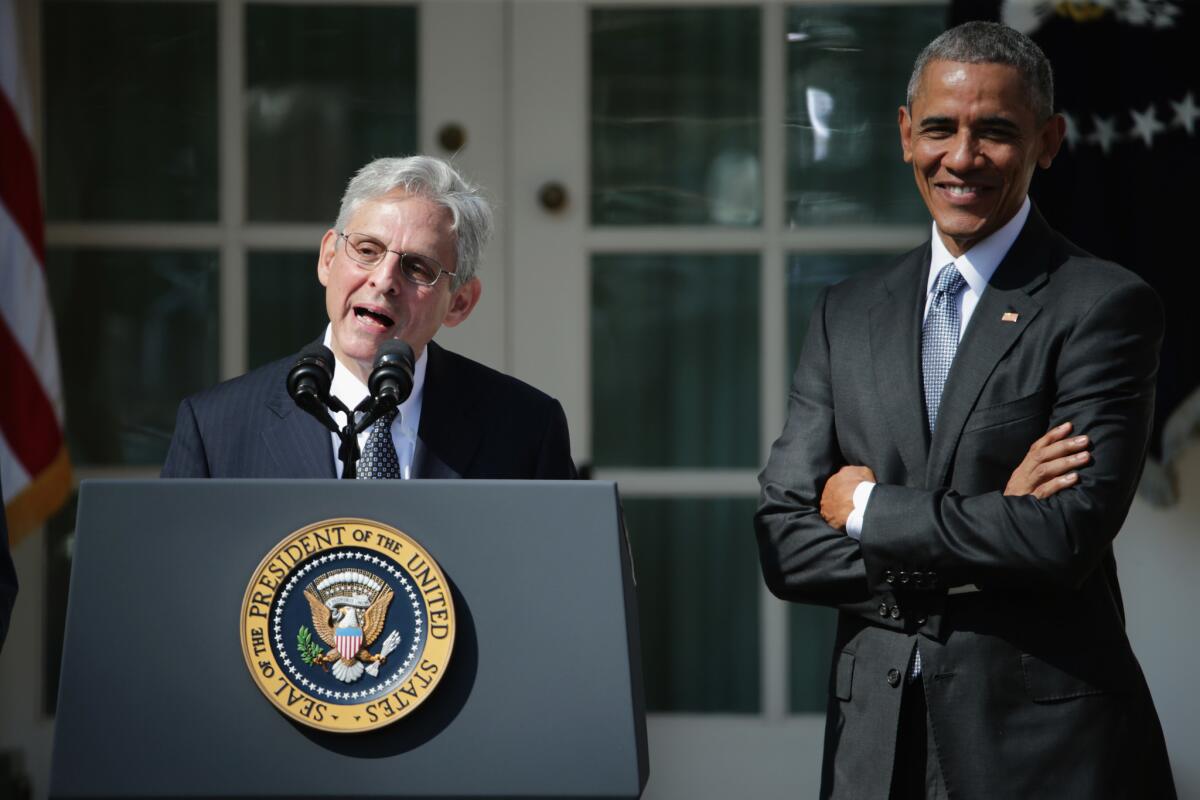Divided Supreme Court opens new term that could bring historic shift

Reporting from Washington ‚ÄĒ An evenly divided Supreme Court opens a new term this week with a few dozen mostly low-profile cases. But perhaps the biggest question of the year won‚Äôt even be settled by the justices.
Instead, voters this November will effectively decide the court’s ideological bent for the next four years and possibly much longer.
Not since 1968 has the high court had a vacancy expected to be filled by the winner of a presidential election.
Back then, Senate conservatives filibustered President Lyndon Johnson’s choice to replace retiring Chief Justice Earl Warren, leaving Richard Nixon to nominate a conservative instead, the start of a quarter-century of Republican appointments that steadily moved the court to the right.
Now, with the GOP-led Senate’s refusal to consider President Obama’s candidate, Merrick Garland, to fill the vacancy created by the death of Antonin Scalia, the high court faces the prospect of a similarly historic shift, albeit in the opposite direction and potentially moving much faster.
If GOP nominee Donald Trump wins in November, conservatives are likely to restore their 5-4 majority, based on the names of prospective nominees his campaign has released.
But a Hillary Clinton victory would give the court a majority of Democratic appointees for the first time since 1969. The Senate could decide to approve Garland in the lame-duck session at the end of the year, or leave the choice to Clinton after she takes office in January.
Either way, it would represent the most liberal high court since the early 1970s.
So what would change?
For starters, liberals could score some short-term victories early next year on several hot-button issues involving Obama‚Äôs executive actions and regulations ‚ÄĒ on immigration, climate change, contraceptives and rights for transgender students.
This past spring, the justices put off several decisions, given the current 4-4 split among Republican and Democratic appointees. For example, they did not decide whether employers at religious schools and colleges can be required to provide free contraceptives for their female employees under the terms of Obama’s healthcare law. That issue remains unresolved, but a fifth Democratic appointee could form a majority to uphold the so-called contraceptive mandate.
In June, the court split, 4-4, on Obama’s plan to defer deportation and offer work permits to more than 4 million immigrants who have been living in the U.S. illegally. The tie vote kept in place a Texas judge’s order that has halted Obama’s policy.
But the case is still pending, and with a fifth Democratic appointee, the court would probably clear the way for the administration to put its policy into effect.
Similarly, earlier this year ‚ÄĒ shortly before Scalia‚Äôs death in February ‚ÄĒ the court by a 5-4 vote temporarily blocked Obama‚Äôs plan to limit carbon pollution from power plants. That case is working its way through the U.S. appeals court and is certain to return to the Supreme Court for a final review, possibly as early as next spring.
The growing dispute over transgender students using bathrooms that match their gender identity could be taken up early next year. A Virginia school district has filed an appeal challenging a decree issued by Obama’s Education Department.
The court has also agreed to decide a potentially significant church-state dispute, but has put off scheduling arguments, apparently waiting for a ninth justice. At issue is whether a church day-care center in Missouri can claim an equal right to state-subsidized playground materials provided to public schools.
A final major decision could come in the area of voting rights. In recent years, Republican-led states have adopted new election laws that limit early voting and require voters to display specific state-issued photo IDs at the polls. These measures have been challenged by civil rights lawyers and the Justice Department who claim that they are designed to restrict voting by African Americans and Latinos.
NEWSLETTER: Get the day‚Äôs top headlines from Times Editor Davan Maharaj ¬Ľ
The court is set to hear cases from North Carolina and Virginia, where Republican lawmakers are accused of setting election boundaries so that black voters are concentrated in a few districts in order to strengthen the GOP in surrounding areas.
‚ÄúThere is no doubt that a liberal court would be more sensitive to claims of voter suppression like we‚Äôve seen in North Carolina and Texas and more vigilant against racial gerrymandering,‚ÄĚ said Steven R. Shapiro, the ACLU‚Äôs national legal director.
Longer term, liberals would have their first opportunity in generations to tee up potentially landmark cases on issues such as partisan gerrymandering, political spending and protecting gays from workplace discrimination.
When conservatives held the majority, liberal and progressive advocacy groups often tried to prevent sensitive issues, like abortion and affirmative action, from reaching the high court. But with a majority of Democratic-appointed justices on the bench, liberal think tanks and civil rights groups would ‚ÄĒ for the first time in years ‚ÄĒ have incentives to cultivate precedent-setting lawsuits and push their issues to the Supreme Court.
For their part, many conservatives say that the prospect of a liberal Democrat filling Scalia’s seat is driving support for Donald Trump.
‚ÄúIt could mean rolling back at the 2nd Amendment and cutting back on religious liberty,‚ÄĚ said Elizabeth Slattery, a legal analyst at the Heritage Foundation. ‚ÄúCitizens United is also on the hit list for the left,‚ÄĚ she said, referring to the 2010 decision that knocked down limits on independent campaign spending by corporations and unions.
She said a liberal court ‚Äúwould not be a check against out-of-control executive power. If Hillary is in office, she could use unelected bureaucrats to achieve the goals she could not win in Congress.‚ÄĚ
My guess is the shift would be fairly slow and incremental, rather than sudden and dramatic.
— Geoffrey Stone, University of Chicago law professor
Legal scholars, however, doubt a newly liberal court would move quickly or aggressively, particularly if the new justice is Garland, who is seen as a moderate.
‚ÄúMy guess is the shift would be fairly slow and incremental, rather than sudden and dramatic,‚ÄĚ said University of Chicago law professor Geoffrey Stone. ‚ÄúThe so-called liberals on the court are by nature and experience fairly cautious and moderate.‚ÄĚ
Conservatives learned that even with a majority, sudden or sweeping change is often difficult to achieve.
When Republicans came to dominate the court in the 1970s and ‚Äė80s, conservatives confidently took aim at liberal precedents like the Miranda decision on police warnings, the Roe vs. Wade ruling on abortion and the Bakke decision allowing race-based affirmative action in colleges and universities.
Despite repeated legal attacks, all three precedents remain standing.
‚ÄúNo matter who a Democratic president appointed, the center of gravity would be with [Justices] Stephen Breyer and Elena Kagan,‚ÄĚ said Walter Dellinger, a former acting solicitor under President Bill Clinton. ‚ÄúThis is not a court that is likely to set about overturning precedents.‚ÄĚ
On Twitter: DavidGSavage
ALSO
The Supreme Court‚Äôs docket is pretty sleepy ‚ÄĒ and that‚Äôs a good thing
Supreme Court turns down Ohio Democrats‚Äô bid to restore ‚Äėgolden week‚Äô of early voting
More to Read
Sign up for Essential California
The most important California stories and recommendations in your inbox every morning.
You may occasionally receive promotional content from the Los Angeles Times.











